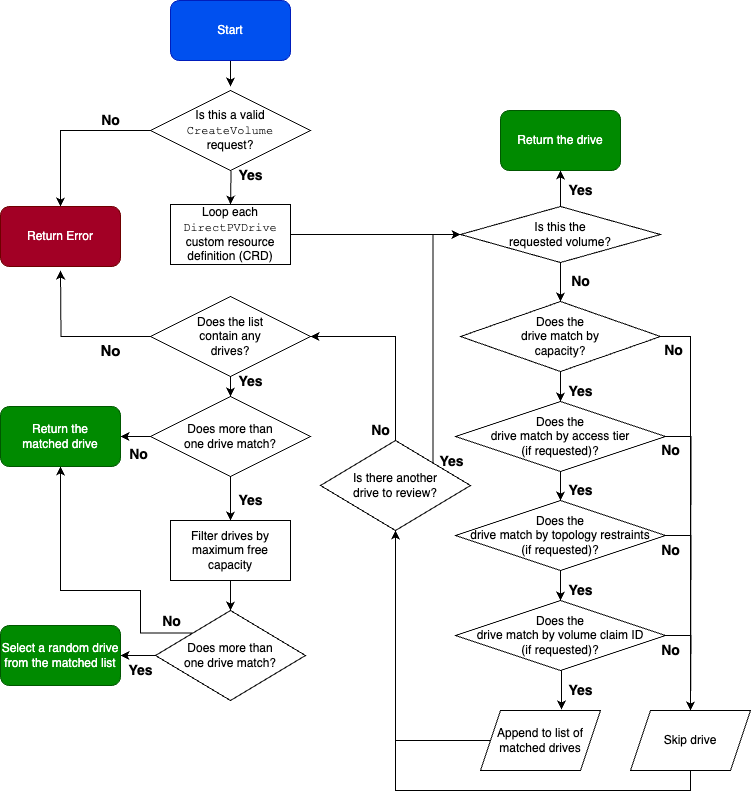Volume Scheduling
Overview
DirectPV provisions drives for pods that provide a PersistentVolumeClaim for the DirectPV storage class.
DirectPV includes a storage class named directpv-min-io with volume binding mode WaitForFirstConsumer.
This mode delays volume binding and provisioning of a PersistentVolume until the creation of a Pod using the PersistentVolumeClaim.
DirectPV then selects or provisions PersistentVolumes that match the topology specified in the Pod’s scheduling constraints.
Volume Constraints
The pod may include additional constraints for the persistent volume claim. DirectPV selects and provisions Persistent Volumes that conform to the topology specified by the Pod’s scheduling constraints.
Some examples of scheduling restraints include:
- resource requirements, such as capacity
- node selectors
- pod affinity and anti-affinity
- taints and tolerations
Drive selection
The following sequence and flowchart show how the DirectPV CSI controller selects a suitable drive for a CreateVolume request.
-
Validate that the filesystem type in the request is
xfs. DirectPV only supports thexfsfilesystem. -
Validate any access-tier in the request.
-
Check for the presence of the volume requested in the
DirectPVDriveCRD object. If present, the DirectPV schedules the first drive containing the volume. -
If no
DirectPVDriveCRD object has the requested volume, DirectPV reviews each drive by:- requested capacity
- access-tier (if requested)
- topology constraints (if requested)
-
If this process selects more than one drive, DirectPV selects the drive(s) with the greatest free capacity.
-
If more than one drive has the same greatest available capacity, DirectPV schedules one of the selected drives at random.
-
Update the scheduled drive with requested volume information.
Note the following behaviors:
- If no drives match, DirectPV returns an error.
- In case of an error, Kubernetes retries the request.
- In the event two or more parallel requests schedule the same drive, the drive successfully schedules for one request. All other requests fail and retry.

Customizing drive selection
DirectPV has several methods for controlling drive selection. These include:
- node selectors
- pod affinity and anti-affinity
- taints and tolerations
In addition to these methods, DirectPV can use drive labels to pick specific drives with a custom storage class for volume scheduling.
-
Label selected drives by label drives command.
# Label the 'nvme1n1' drive in all nodes as 'fast' with the 'tier' key. kubectl directpv label drives --drives=nvme1n1 tier=fast -
Create a new storage class with drive labels using the create-storage-class.sh script.
# Create new storage class 'fast-tier-storage' with drive labels 'directpv.min.io/tier: fast' create-storage-class.sh fast-tier-storage 'directpv.min.io/tier: fast' -
Use the newly created storage class in volume provisioning.
$ kubectl apply -f - <<EOF apiVersion: v1 kind: PersistentVolumeClaim metadata: name: sleep-pvc spec: volumeMode: Filesystem storageClassName: fast-tier-storage accessModes: [ "ReadWriteOnce" ] resources: requests: storage: 8Mi EOF
Unique Drive selection
The default free capacity based drive selection leads to allocating more than one volume in a single drive for StatefulSet deployments. Such selection lacks performance and high availability for an application like MinIO object storage.
To overcome this behavior, DirectPV provides a way to allocate one volume per drive.
To use this feature, create a custom storage class with a label in a format such as directpv.min.io/volume-claim-id.
Below is an example to create custom storage class using the create-storage-class.sh script:
create-storage-class.sh tenant-1-storage 'directpv.min.io/volume-claim-id: 555e99eb-e255-4407-83e3-fc443bf20f86'
This custom storage class has to be used in your StatefulSet deployment. Below is an example to deploy MinIO object storage:
kind: Service
apiVersion: v1
metadata:
name: minio
labels:
app: minio
spec:
selector:
app: minio
ports:
- name: minio
port: 9000
---
apiVersion: apps/v1
kind: StatefulSet
metadata:
name: minio
labels:
app: minio
spec:
serviceName: "minio"
replicas: 2
selector:
matchLabels:
app: minio
template:
metadata:
labels:
app: minio
directpv.min.io/organization: minio
directpv.min.io/app: minio-example
directpv.min.io/tenant: tenant-1
spec:
containers:
- name: minio
image: minio/minio
env:
- name: MINIO_ACCESS_KEY
value: minio
- name: MINIO_SECRET_KEY
value: minio123
volumeMounts:
- name: minio-data-1
mountPath: /data1
- name: minio-data-2
mountPath: /data2
args:
- "server"
- "http://minio-{0...1}.minio.default.svc.cluster.local:9000/data{1...2}"
volumeClaimTemplates:
- metadata:
name: minio-data-1
spec:
storageClassName: tenant-1-storage
accessModes: [ "ReadWriteOnce" ]
resources:
requests:
storage: 16Mi
- metadata:
name: minio-data-2
spec:
storageClassName: tenant-1-storage
accessModes: [ "ReadWriteOnce" ]
resources:
requests:
storage: 16Mi